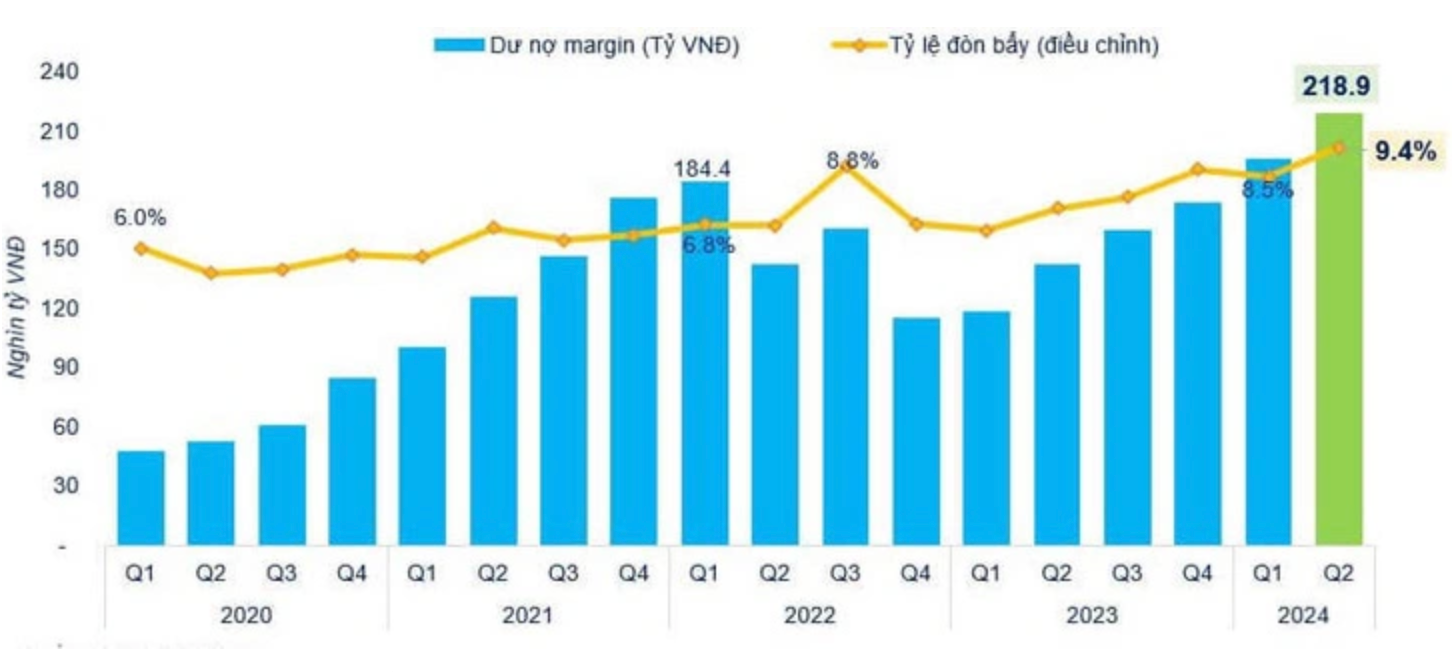Dư nợ margin công ty chứng khoán cao kỷ lục

![]()
Dư nợ cho vay margin công ty chứng khoán lập kỷ lục mới
Thị trường chứng khoán Việt Nam khép lại quý II/2024 với nhiều biến động mạnh mẽ và khó đoán, nhưng thanh khoản lại có phần sụt giảm, biểu hiện bằng chỉ số VN-Index có nhiều đợt tăng mạnh và giảm sốc. Trong bối cảnh đó, dư nợ cho vay ký quỹ (margin) của các công ty chứng khoán lại được đẩy lên mức kỷ lục.
Trong quá khứ, dư nợ margin thường tăng mạnh khi thị trường đạt đỉnh, nên bất ngờ ở chỗ, trong 6 tháng đầu năm, vay margin tăng nhanh diễn ra trong giai đoạn thị trường chứng khoán biến động mạnh, thanh khoản không đột biến, thậm chí giảm.
Đầu tháng 4/2024, VN-Index rơi từ vùng 1.280 xuống dưới 1.180 điểm. Chỉ số chung của thị trường được kéo lại trong tháng 5, nhưng vẫn thất bại khi chinh phục ngưỡng tâm lý 1.300 điểm. Cuối tháng 6, thị trường tiếp tục điều chỉnh về 1.250 điểm với thanh khoản sụt giảm.

Dư nợ cho vay (chủ yếu là dư nợ cho vay ký quỹ) của các công ty chứng khoán tiếp tục tăng trưởng mạnh.
Điển hình tại Công ty TNHH Chứng khoán ACB (mã: ACBS), tại thời điểm 30/6/2024, dư nợ cho vay tiến lên mốc kỷ lục, đạt hơn 7.500 tỷ đồng, tăng 64% so với đầu năm. Ngoài ra, lượng tiền và tương đương tiền cũng đột biến lên hơn 2.881 tỷ đồng, gấp 5,7 lần đầu năm và cao nhất lịch sử Công ty.
Đáng nói, tính đến 30/6/2024, dư nợ phải trả của ACBS cũng được đẩy lên mức kỷ lục. Gần như toàn bộ nợ phải trả đều đến từ việc đi vay ngắn hạn, ghi nhận hơn 13.431 tỷ đồng. So với đầu năm, dư nợ vay của ACBS tăng mạnh tại các ngân hàng Vietcombank, BIDV, Indovina, Woori Việt Nam – Chi nhánh Bình Dương, bên cạnh phát sinh mới nợ vay tại Techcombank, Eximbank, MBBank, ABBank và Công ty tài chính TNHH MB Shinsei (Mcredit).
Tương tự, dư nợ cho vay tại CTCP Chứng khoán SSI (HOSE: SSI) tăng gần 35% so với đầu năm, trong đó, dư nợ cho vay ký quỹ đạt hơn 19.500 tỷ đồng. Mức dư nợ margin này đã gần đạt ngưỡng kế hoạch 20.000 tỷ đồng, Công ty đề ra cho cuối năm 2024.
Đặc biệt, tại thời điểm 30/6/2024, Chứng khoán TP.HCM (mã: HSC) ghi nhận dư nợ cho vay ký quỹ tăng hơn 50% so với đầu năm, đạt hơn 18.500 tỷ đồng.
Ngoài ra, mảng cho vay margin trong quý II/2024 của Chứng khoán VNDirect khởi sắc với lãi đạt hơn 299 tỷ đồng, tăng 9% so với cùng kỳ. Do đó, dư nợ cho vay margin tăng 10% so với đầu năm, ghi nhận ở mức 10.936 tỷ đồng.
Đáng chú ý, quy mô cho vay tại Chứng khoán Tiên Phong (TPS) – công ty chứng khoán trong hệ sinh thái của TPBank tăng trưởng mạnh mẽ. Tính đến 30/6/2024, hoạt động cho vay ký quỹ cho thấy sự tăng trưởng mạnh mẽ, thể hiện ở quy mô các khoản cho vay đạt 2.306 tỷ đồng, tăng 111% so với đầu năm.
Tương tự, tính đến 30/6/2024, dư nợ cho vay ký quỹ và ứng trước tiền bán tại Chứng khoán MB (MBS) – công ty chứng khoán trong hệ sinh thái của Ngân hàng MBBank đạt 9.979 tỷ đồng. Trong đó, dư nợ cho vay margin chiếm 9.823 tỷ đồng, tăng 6%. Như vậy, dư nợ margin đã tăng quý thứ 6 liên tiếp.
 Dư nợ cho vay margin lập kỷ lục mới. Nguồn: FiinGroup
Dư nợ cho vay margin lập kỷ lục mới. Nguồn: FiinGroup
Trong 6 tháng đầu năm, một số công ty chứng khoán cũng công bố con số dư nợ cho vay ký quỹ đầy ấn tượng. Điển hình như, Chứng khoán VPBankS có dư nợ cho vay margin đạt 9.100 tỷ đồng. Dư nợ cho vay ký quỹ của Chứng khoán Vietcap (mã: VCI) tính đến cuối tháng 6/2024 đạt 7.947 tỷ đồng. Còn tại Chứng khoán Vietcombank (VCBS) dư nợ cho vay margin đã đạt đến 5.901 tỷ đồng.
Trong quý II/2024, CTCP Chứng khoán KB Việt Nam (KBSV) tăng thêm 1.264 tỷ đồng quy mô cho vay, lên gần 6.275 tỷ đồng, phần lớn là số tiền cho nhà đầu tư vay margin. Do đó, dư nợ cho vay cũng đang chiếm tỷ trọng lớn nhất trong tổng tài sản của KBSV, khoảng 65%. Còn tại Chứng khoán BIDV (BSC – mã chứng khoán: BID), dư nợ cho vay (hầu hết là cho vay margin) tính đến hết quý 2/2024 đạt hơn 5.200 tỷ đồng, tăng gần 1.000 tỷ đồng so với đầu năm.
Các ngân hàng đều đang đẩy mạnh việc cho vay các công ty chứng khoán
Dư nợ margin của các công ty chứng khoán tăng cao liên tục và đạt mức đỉnh mới từ năm 2023. Đến nửa đầu năm 2024 tiếp tục chứng kiến sự gia tăng mạnh mẽ của dư nợ margin, biến đây thành nguồn doanh thu quan trọng và mang lại lợi nhuận chính cho các công ty chứng khoán.
Cùng với xu hướng tăng margin, tỷ lệ an toàn vốn đòi hỏi các công ty chứng khoán phải có vốn chủ sở hữu đủ lớn vừa cân đối tăng vốn vay để kịp thời đáp ứng sự mở rộng nhanh chóng của dư nợ margin. Đây là yếu tố quan trọng, bởi nó không chỉ tạo ra lợi nhuận cho công ty mà còn tạo ra áp lực tăng vốn vay nhanh trong thời gian ngắn.
Dư nợ tăng mạnh mẽ đòi hỏi sự hỗ trợ rất lớn từ nguồn vốn. Đi vay sẽ là lựa chọn phổ biến cũng như là phương án linh hoạt mà nhiều công ty chứng khoán đang thực hiện để bổ sung nguồn vốn kinh doanh ký quỹ. Mức vay nợ của các công ty chứng khoán đã gia tăng mạnh trong những quý gần đây, đặc biệt là trong nửa sau năm 2023.
Với ngân hàng, việc cho vay các công ty chứng khoán được xem là một lĩnh vực có mức độ an toàn cao, bởi khoản vay thường được bảo đảm bởi danh mục đầu tư chứng khoán, bao gồm các tài sản tài chính có tính thanh khoản cao như trái phiếu tại các công ty này. Khi thị trường chứng khoán tăng trưởng, giá trị danh mục đầu tư của các công ty chứng khoán tăng lên, giúp giảm rủi ro cho ngân hàng. Vì vậy, các ngân hàng sẵn sàng đẩy mạnh cho vay trong phân khúc này.
Mặt khác, việc gia tăng vay nợ cho thấy sự phụ thuộc ngày càng lớn của các công ty chứng khoán vào vốn vay ngân hàng.
Đáng lưu ý, hoạt động cho vay margin còn bị hạn chế trong tỷ lệ an toàn vốn. Cụ thể, tỷ lệ dư nợ cho vay margin/ vốn chủ sở hữu không được vượt quá 200%. Vì vậy, dù bổ sung vốn vay, tăng cường vốn tự có là yêu cầu không thể tránh nếu các công ty chứng khoán tiếp tục tăng trưởng dư nợ trong thời gian tới.
Lê Thanh
Theo tudonghoangaynay.vn Copy







